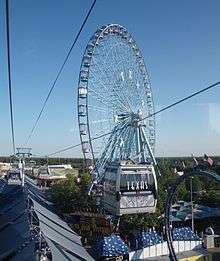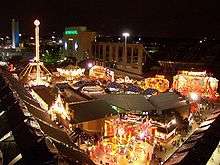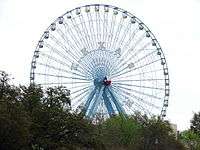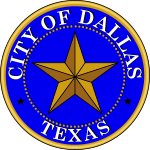State Fair of Texas
| State Fair of Texas | |
|---|---|
 | |
 The State Fair of Texas | |
| Genre | State fair |
| Dates |
Starts last Friday of September and last 24 days. 28 September–21 October 2018. |
| Location(s) |
Fair Park 1300 Robert B Cullum Boulevard Dallas, TX 75210 |
| Years active | 1886–1916, 1919–41, since 1945. |
| Attendance | 2,250,433 (2017) |
| Website | Official website |
The State Fair of Texas is an annual state fair held in Dallas at historic Fair Park. The fair has taken place every year since 1886 except for varying periods during World War I and World War II.[1] It usually begins the last Friday in September and ends 24 days later. While an annual attendence of over 2 million,[2] it is consistently recognized as one of the most highly attended and best state fairs in America as well as Dallas's signature event.[3][4][5]
Attractions

The State Fair of Texas opening day ceremonies are highlighted by the annual Friday parade rolling through downtown Dallas.[6]
Traditionally, the centerpiece of the fair has been the annual college football game between Oklahoma and Texas, nicknamed the Red River Rivalry (historically known as both the "OU-Texas Game" or "Texas-OU Game") and played in the Cotton Bowl at Fair Park. Also, the State Fair Classic, featuring Grambling State University and Prairie View A&M University, is played at the Cotton Bowl during the fair. In 2010, Baylor and Texas Tech played their game during the fair for the first time. During the opening weekend of the 2013 fair, Army and Louisiana Tech played in the only Heart of Dallas Classic at the Cotton Bowl; it was abandoned thereafter. The new Texas State Fair Football Showdown is scheduled to take place on the third weekend of the 2018 and 2019 fair and will feature Southern and Texas Southern.[7]
The State Fair of Texas is the only fair in the US to include a full auto show, dating back to 1913.[8]
The State Fair used to feature "Birds of the World" where several birds flew overhead. It was removed from the Fair lineup in 2014. The Texas Skyway is a gondola ride which only operates 24 days a year transports visitors around the fairgrounds. Its construction cost 5 million dollars. There is also a BMX bike show as well as dog and pig races. For children, puppet shows, Children's Medical Center Barnyard, and Story Time also take place inside the fair.[9]
In recent years, the fair has emphasized its reputation as an event featuring unique, albeit high-fat foods. It has been known for years for Fletcher's brand corny dogs. Recent years have seen the introduction of new unusual deep-fried items, including deep-fried Oreos, deep-fried Twinkies, deep-fried s'mores, deep-fried pork ribs, fried cheesecake; deep-fried butter, fried avocados, deep-fried peanut butter, jelly, and banana sandwiches, and most recently a batter-based fried Coke. New foods in 2008 included chicken fried bacon and fried banana splits. For the 2012 fair, the Girl Scouts of Northeast Texas added the deep-fried Samoa cookie.[10]
History
Originally what was known as the State Fair of Texas was held in Houston from 1870 through 1878.[11]
In its modern incarnation, the State Fair of Texas was charted as a private corporation by local businessmen. It was an immediate success and attracted thousands of people. However, in 1904 a series of events led to a financial crisis and not enough income was available to keep the fair running. Therefore, the businessmen sold it to the city of Dallas with the agreement that 24 days during the fall would be set aside annually for the fair and exhibition.[12]
Big Tex, a 55-foot (17 m) tall cowboy statue, has been its symbol since his introduction in 1952. In 1953, Big Tex's jaw was hinged, so that he appears to "speak" the announcements that promote fair events.[13] After a fire on October 19, 2012 destroyed the original Big Tex, he was rebuilt and reintroduced for the 2013 fair. Big Tex is claimed to be the world’s tallest cowboy[14].
Its 212-foot (65 m) Texas Star Ferris wheel was the largest in North America when it debuted in October 1985, just months before the Texas Sesquicentennial. It has since been dwarfed by Ferris wheels in Las Vegas and Orlando.[8][15]
DART's Fair Park Station and MLK Jr. Station opened in 2009 to serve Fair Park and the State Fair. In addition to regular service on the Green Line, the Red Line and Blue Line also run "special event" trains to Fair Park Station for major fair events.[16]
Controversies
In 1955, Juanita Craft organized a protest of the State Fair of Texas against its policy of admitting blacks only on "Negro Achievement Day." [17]
The State Fair in 1966 commissioned a report on the redevelopment of the fair, which concluded that the land around Fair Park should be `bought up and turned into a paved, lighted, fenced parking lot" that would `eliminate the problem from sight'. "If the poor Negroes in their shacks cannot be seen, all the guilt feelings…will disappear, or at least be removed from primary consideration".
The State Fair came under fire in October 2014 for spending over $5,000,000 on attorneys fees to two insiders.[18]
Despite a $30,000,000 investment in Summer Adventures, the event was shuttered after just one season.[19]
In August 2015, the State Fair was sanctioned more than $75,000 for filing a SLAPP suit[34] against a lawyer who had requested financial documents from the State Fair. On August 2, 2016, the Dallas Court of Appeals reversed in its entirety the judgment against the State Fair of Texas, holding that the trial court erred in, among other things, finding that the State Fair's lawsuit was a SLAPP suit.[20]
Timeline

- The State Fair of Texas opened its gates for the first time on October 26, 1886. Approximately 14,000 people attend the opening day.
- On November 7, 1886, the fair closes and attracted over 100,000 people for the very first year.
- The State Fair of Texas has a history of racial discrimination dating back to the 1880s. The first designated day for African-Americans to attend the fair was held in 1889 and was called "Colored People's Day." Educator Norman Washington Harllee organized exhibits and planned events and speakers including Booker T. Washington in 1900. In 1910, "Colored People's Day" was discontinued and reappeared in 1936 as "Negro Achievement Day" set to coincide with the Texas Centennial Exposition. Contrary to the fact that African-Americans weren’t allowed to participate in entertainment or eat at restaurants and concession stands on other days during the run, fair officials touted "Negro Achievement Day" as a way to recognize the accomplishments and progress of the Negro race in Texas and the United States. The Hall of Negro Life was the only building demolished after the Texas Centennial ended.[21]
- In 1913, the fair introduces the first Automobile building which was filled with 175 vehicles for fairgoers to see.
- The fair was canceled in 1918 due to the US Army taking control of Fair Park to establish an aviation boot camp known as Camp Dick.
- In 1921, Boston College beats Baylor at the first game ever played between teams from the southwest and northeast.
- In 1921, Texas and Vanderbilt start a series which is played here every year from 1921 to 1928 with the exception of 1924.
- In 1923, the fair hosted Ku Klux Klan day. Thousands of new Klan members were sworn in at the fairgrounds. More than 150,000 people were at the fair that day.[22]
- In 1925, the first State Fair Classic is played.
- In 1929, TX-OU play their Red River Rivalry here for the first time.
- In 1930, construction of a new Fair Park Stadium (now known as the Cotton Bowl) begins.
- In 1932, TX-OU play their Red River Rivalry for the first time at the new Fair Park Stadium.
- In 1937, the first Cotton Bowl Classic is played in Fair Park.
- Big Tex makes his first appearance in 1952.
- In 1955, a seat filled with members of the Memphis High School marching band broke free from the top of a 92-foot Sky Wheel, killing a 15-year-old girl.[23]
- In 1956 the Trailblazer monorail began operation at Fair Park from 1956 to 1964. It was the first commercially operated monorail system in the United States.
- Elvis Presley performs in the Cotton Bowl during the fair in 1956.
- In 1960, the Dallas Texans (AFL) and the Dallas Cowboys (NFL) play their first season in the Cotton Bowl.
- In 1964 the monorail closed and was replaced by the Swiss Sky Ride, a 64 car aerial ride that traveled over a 3,800 foot path (the longest ever built).
- In 1966, the State Fair commissioned a report on the redevelopment of the fair, which concluded that the land around Fair Park should be `bought up and turned into a paved, lighted, fenced parking lot" that would `eliminate the problem from sight'. "If the poor Negroes in their shacks cannot be seen, all the guilt feelings…will disappear, or at least be removed from primary consideration".[24]
- In 1979, a Sky Ride accident occurred during the last day of the fair, prompting the removal of the attraction.
- In 1983, an eighteen-year-old boy was killed and several bystanders were injured when a gondola fell off the Enterprise (ride).
- In 1985 the Texas Star opens as the largest ferris wheel in North America.
- In 1989, The Comet Roller Coaster, a Fair Park landmark since 1947, is torn down.
- Following the 2001 September 11 attacks, Dallas police and State Fair officials announce the implementation of new security measures during the annual event.
- In 2005, the Fried Peanut Butter, Jelly and Banana Sandwich is introduced to the fair.

- In 2007 the Texas Skyway aerial ride opens in Fair Park.
- In 2010, the 8000 ft Greenhouse on the Midway is built to house 1000 hanging baskets, beehives, and Farmer Mike the Pumpkin Carver.
- Fairgoers spent more than $37 million in 2010 which broke the fair's record.
- On November 14, 2011 – State Fair of Texas filed its 2010 IRS Form 990 Tax Return.[25]
- On October 19, 2012, Big Tex caught on fire, burning it down to the skeletal frame, with only the right arm remaining.
- On November 15, 2012 – State Fair of Texas filed its 2011 IRS Form 990 Tax Return.[26]
- In 2013:
- The State Fair opened a brand new attraction – a 500-foot observation tower called "Top o' Texas Tower" – as part of a renovation of part of the Midway called "Summer Adventures at Fair Park."[27] The "Tower" now operates only 24 days a year, despite a construction cost of over $11,000,000.
- The State Fair also operated Summer Adventures in Fair Park, a beach-themed amusement park from May to August 2013.[28]
- Despite a $30,000,000 investment in Summer Adventures, the event was shuttered after just one season.[19]
- Jim Schutze of the Dallas Observer wrote, "The sudden collapse of a $30 million venture has to be some kind of red flag, some indication that it's time to re-examine the whole thing."[29]
- A new Big Tex statue was unveiled the day before the fair opened.[30]
- On November 12, 2013 – State Fair of Texas filed its 2012 IRS Form 990 Tax Return.[31]
- In 2014:
- In September 2014, a blue ribbon task force appointed by Mayor Mike Rawlings submitted a report on the rejuvenation of Fair Park.[32] The Mayor's Task Force plan envisions a public-private partnership led by a non profit organization to be charged with over arching powers to control the revitalization of Fair Park, including the State Fair of Texas.[33] Architect/City planner Antonio Di Mambro, with international experience in infrastructure planning and neighborhood revitalization, encouraged the Mayor to use the Task Force report as a building block for constructive dialogue with residents, stakeholders and the neighborhoods around Fair Park.[34] Following the presentation of the Task Force Plan, Mayor Mike Rawlings said, "I felt passion by all the council and park board members that they want Fair Park to be all it can be and they're interested in taking this big challenge on".[35]
- October – State Fair comes under fire for spending over $5,000,000 on attorneys fees to two insiders.[18]
- November 7, 2014 -State Fair of Texas filed its 2013 IRS Form 990 Tax Return, indicating a loss of over $2,000,000 for the reporting period.[36]* In 2015:
- In March 2015, the State Fair pushed back on any notion of tightening up the footprint of its current operation. Dallas Morning News reporter Robert Wilonsky called the State Fair's response "rather dramatic" The article also quoted Stephen Page of the closed Texas Museum of Automotive History from 2012 as saying, "The City's requirement that tenants vacate the majority of the buildings in Fair Park during the State Fair is the principal reason for Fair Park's ongoing decline." Wilonsky also quoted a ‘prominent member of the Mayor's Task Force’ as suggesting privately "that the State Fair's presence at Fair Park also needs to be greatly reduced."[37]
- In May 2015, the Park and Recreation Board voted unanimously to recommend and approve the Mayor's Task Force Plan and recommended that underground parking structures be built rather than as initially recommended by the Task Force.[38]
- In August 2015, the State Fair was sanctioned more than $75,000 for filing a SLAPP suit[39] against a lawyer who had requested financial documents from the State Fair.[40] On August 2, 2016, the Dallas Court of Appeals reversed in its entirety the judgment against the State Fair of Texas, holding that the trial court erred in, among other things, finding that the State Fair's lawsuit was a SLAPP suit.[20]
Economics, finances and management
The economics, finances and management of the State Fair of Texas is a matter of public concern and study. The five main areas of concern are:
- What is the annual attendance of the fair?
- What economic impact does the fair have on people and businesses in the surrounding area?
- How much money does the State Fair provide for the benefit of improvements at Fair Park and elsewhere
- State fair staff compensation levels
- Audits
Attendance
Staff of the State Fair have traditionally reported that attendance at the fair runs in the vicinity each year of between 3 and 3.5 million people. These figures were disputed in an April 2016 study published by Tom Kelly, Ph.D, a professor of Economics at Baylor University and the Director of Baylor University Center for Business and Economic Research, along with Bennet Hickok, an Economics student at Baylor. The Kelly/Hickok report argues that the attendance at the fair is about 1.5-1.7 million visitors a year, or about half of what state fair staff reported it to be.[41]. According to the 2017 State Fair of Texas Annual Report[42], the Fair attracted a total of 2,250,433 attendees during the 2017 event with roughly 93,000 daily guests.
Economic impact on surrounding businesses
The 2016 Kelly/Hickok study found that the State Fair generates around $50 million for the area economy. This is in contrast to the figure of $600 million in impact that the State Fair itself has traditionally reported.[43][44][45]
How excess revenue is spent
The State Fair has a lease with Fair Park, the terms of which require that any profit or excess revenue it generates be spent "for the development and enhancement of Fair Park and the Fair". In May 2016, the State Fair released a list of capital projects for the past 10 years, detailing how the fair had spent their excess revenue. According to media reports, 90% of excess revenue was spent on projects that solely benefited the State Fair. A survey of Fair Park revealed out of the 277 acres available, 200 are covered in asphalt or concrete, compared to 10 acres of green space.[46]
Staff compensation
In 2014, Errol McKoy, the former President of the State Fair of Texas, received $1.425 million in compensation.[47][48][49]
Audits
On May 13, 2016, the City of Dallas Auditor, Craig Kinton, released an audit regarding Fair Park Business Partners, which included the State Fair of Texas. The audit concluded the City of Dallas had no way to ensure the State Fair was adequately investing in Fair Park, per the terms of the contract between the City of Dallas and State Fair.[50]
See also
Notes
- ↑ Bigtex.com Archived 2014-02-13 at the Wayback Machine.
- ↑ "Daily Attendence". The State Fair of Texas. Retrieved October 11, 2018.
- ↑ Lipsey, Sid; Travel, Yahoo (June 5, 2014). "The 7 best state fairs in America". New York Post.
- ↑ "America's 5 Best State Fairs". Retrieved 26 August 2017.
- ↑ Chieftain, Pueblo. "chieftain.com". Pueblo Chieftain. Retrieved 26 August 2017.
- ↑ "State Fair of Texas: Opening Day Parade - Dallas Socials". 25 September 2014. Retrieved 26 August 2017.
- ↑ Luke Johnson (October 8, 2016). "'This is a major deal:' Southern to play Texas Southern in 2018–19 Texas State Fair Football Showdown". theadvocate.com. Retrieved October 16, 2016.
- 1 2 "What makes us unique," Archived 2008-09-13 at the Wayback Machine. BigTex.com. Retrieved 2008-09-24.
- ↑ "Official website of The State Fair of Texas".
- ↑ Tepper, Rachel (July 11, 2012). "Deep-Fried Samoa Girl Scout Cookies Hit The State Fair Circuit". Huffington Post.
- ↑ Meeks, Flori (March 28, 2013). "Few traces remain of state fair site". Houston Chronicle. Retrieved May 22, 2018.
- ↑ Nancy Wiley, "State Fair of Texas", Handbook of Texas Online (http://www.tshaonline.org/handbook/online/articles/lks02), accessed August 16, 2012. Published by the Texas State Historical Association.
- ↑ Steven Butler. Fair Park Timeline, part 4: The Post-Exposition Years (1938-1984)
- ↑ State Fair of Texas rove.me
- ↑ Norman Anderson. Ferris wheels: an illustrated history, Popular Press, 1992, page 138-40.
- ↑ Dallasnews.com Archived 2009-09-26 at the Wayback Machine.
- ↑ Women In Texas History - Juanita Craft
- 1 2 Phillips, L. P. "State Fair Of Texas Pays 'Above Average' Legal Bills". Retrieved 26 August 2017.
- 1 2 "There won't be Summer Adventures in Fair Park this year". 18 February 2014. Retrieved 26 August 2017.
- 1 2 "Dallas Court of Appeals Opinion".
- ↑ "Dallas Public Library - Site Map" (PDF). dallaslibrary2.org. Retrieved 26 August 2017.
- ↑ "Everything you need for the State Fair of Texas". GuideLive. Retrieved 26 August 2017.
- ↑ "Ferris Wheel Seat Plunges Killing Girl". www.news.google.com/newspapers. The Bulletin. Retrieved 10 October 2015.
- ↑ "University of North Texas Digital Library, "Fair Park Expansion: A Case Study of Political Bias and Protest in Urban Politics", Davies, Elizabeth Durham. Accessed August 25, 2016". Retrieved 26 August 2017.
- ↑ IRS 990 Year 2010 Return of Organization Exempt from Income Tax, "State Fair of Texas"
- ↑ IRS 990 Year 2011 Return of Organization Exempt from Income Tax, "State Fair of Texas"
- ↑ "Get your thrills on the $12 million adrenaline rush now open at Fair Park". Retrieved 26 August 2017.
- ↑ http://www.fairpark.org/index.php?option=com_content&view=article&id=216
- ↑ Schutze, Jim (21 February 2014). "Fair Park's Summer Amusement Venture Is Dead. Is Anyone Surprised?". Retrieved 26 August 2017.
- ↑ "Big Tex Makes His Debut One Day Early". Retrieved 26 August 2017.
- ↑ IRS 990 Year 2012 Return of Organization Exempt from Income Tax, "State Fair of Texas"
- ↑ "Dallas council enthusiastic about proposal to privatize Fair Park". 3 September 2014. Retrieved 26 August 2017.
- ↑ "Archived copy" (PDF). Archived from the original (PDF) on 2014-10-13. Retrieved 2014-10-13.
- ↑ "Include edges in Fair Park revitalization". 9 September 2014. Retrieved 26 August 2017.
- ↑ "Dallas Leaders Praise New Fair Park Plan". Retrieved 26 August 2017.
- ↑ IRS 990 Year 2013 Return of Organization Exempt from Income Tax, "State Fair of Texas"
- ↑ "Plan to reduce State Fair space would end its run, official says". 26 March 2015. Retrieved 26 August 2017.
- ↑ "Dallas Park Board has signed off on Rawlings task force's proposal to privatize Fair Park". 23 May 2015. Retrieved 26 August 2017.
- ↑ Strategic lawsuit against public participation
- ↑ "Judge sanctions State Fair of Texas after it sued lawyer who wants to see Big Tex's checkbook". 14 August 2015. Retrieved 26 August 2017.
- ↑ Kelly, Tom; Hickok, Bennet (April 2016). "Reassessing the Economic Impact of Fair Park and the State Fair" (PDF). Baylor University. Retrieved 27 July 2016.
- ↑ 2017 State Fair of Texas Annual Report Retrieved Jul 15, 2018
- ↑ Shipp, Brett (May 4, 2016). "Economist's study raises eyebrows about State Fair's future in Fair Park". WFAA. Retrieved 27 July 2016.
- ↑ Thompson, Steve (April 15, 2016). "How valuable is Big Tex to Dallas? State Fair's fuzzy numbers make it hard to tell". The Dallas Morning News. Retrieved 27 July 2016.
- ↑ Thompson, Steve (April 19, 2016). "Big Tex's economic impact? Try $50 million, says new study on the State Fair". The Dallas Morning News. Retrieved 27 July 2016.
- ↑ Wilonsky, Robert (May 13, 2016). "Dallas isn't keeping a close eye on Big Tex and city's other Fair Park partners, says audit". The Dallas Morning News. Retrieved 27 July 2016.
- ↑ Thompson, Steve (April 22, 2016). "Big Tex tries to be more transparent about State Fair spending". The Dallas Morning News. Retrieved 27 July 2016.
- ↑ Cassidy, Jon (May 2, 2016). "State Fair's expenses help explain Fair Park's blight". Watchdog.org. Retrieved 27 July 2016.
- ↑ "STATE FAIR OF TEXAS". Economic Research Institute. Retrieved 27 July 2016.
- ↑ Kinton, Craig (May 13, 2016). "AUDIT OF FAIR PARK BUSINESS PARTNERS OVERSIGHT" (PDF). Office of the Dallas, Texas City Auditor. Retrieved 27 July 2016.
External links
| Wikimedia Commons has media related to Texas State Fair. |
